In this comprehensive post, we'll go over;
What an Ice Dam is, and how to prevent them.
You'll also learn;
- Where to find them.
- Solutions and Tips to prevent them.
- Ice Dam removal.
- Damage caused by Ice Dams.
So if you've ever asked yourself any of these questions, you'll love this post!
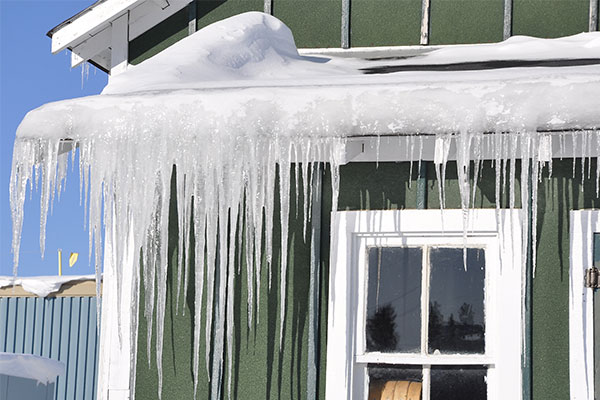
Being a home or business owner definitely has its ups and downs. Every winter comes with the constant wonder of what the weather will be like. Some can be milder with a small amount of snow.
Other winters seem to last forever and can be bitter cold with tons of snow. Regardless, each winter comes with the concerns of Ice Dams.
Keep reading to learn everything you need to know about an ice dam.
What Is An Ice Dam?
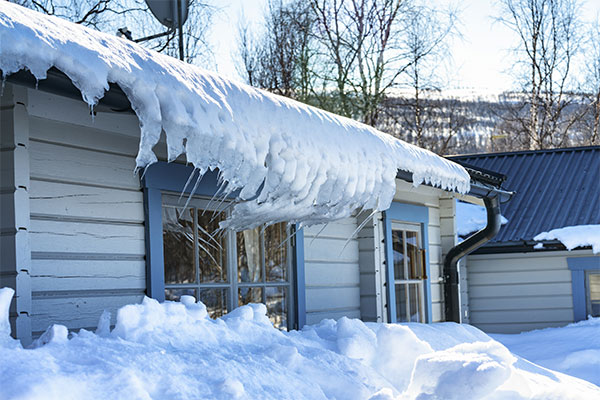
During the cold winter months, homeowners and property owners have more to worry about than just snowy driveways and parking lots. Ice dams are an all too common problem.
An ice dam occurs when the heat from inside rises into the attic or roof space and warms up the roof. Any snow on the roof in that area begins to melt. Melting snow means water, and we all know that water can’t stay on any angled surface.
Ultimately, the water will flow towards the edge of the roof. If there is still snow on the roof in an area that is cold or frozen, the melted snow water will freeze thus adding more ice and creating an ice dam.
Depending on where you live, there might be many months that snow will fall (and stick). In the Rochester, NY area, snow can start falling mid-October all the way through to April sometimes.
However long you may have snowfall, ice dams are most often to occur between December and February.
Likely Candidates for Ice Dams
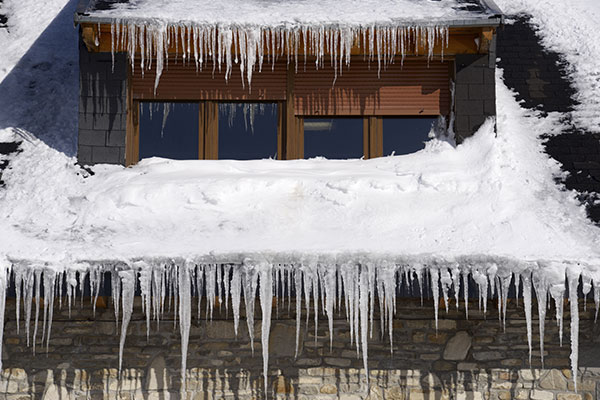
There are several different styles of roofs for buildings. There are flat roofs, gambrel, hip & cross-hipped, and also gable & cross-gabled, and a few others. Ice dams are likely to form in areas where parts of the roof meet, like a seam.
Due to the nature of ice dams and how they occur (escaping heat), you won’t find a formation of ice dams in areas such as a garage or porch unless the area is heated (most are unheated).
However, there are common areas where ice dams can be found, and pose the threat of water damage to the home or building.
Eaves: 80% of ice dams occur in the eaves of a roof. Lower pitched roofs can cause significant leaks and water damage.
Valleys: are usually found around dormers and can be a great place for ice dams to form.
Skylights: Ice dams can build-up above or below a skylight and cause significant damage.
Openings: Any area with a vent or pipe can be a source of heat escaping which can cause an ice dam.
Interior Rooms: Areas with high, vaulted ceilings can get large ice dams. The higher ceilings are often harder to properly ventilate.
When parts of the roof have melted snow, the water will flow down but once it gets to an unheated area, it will refreeze again. Being steep, the ice dams that form could be significantly larger. Bathrooms could pose a higher risk for ice dams as well if not properly ventilated.
Ice Dam Prevention & Solutions
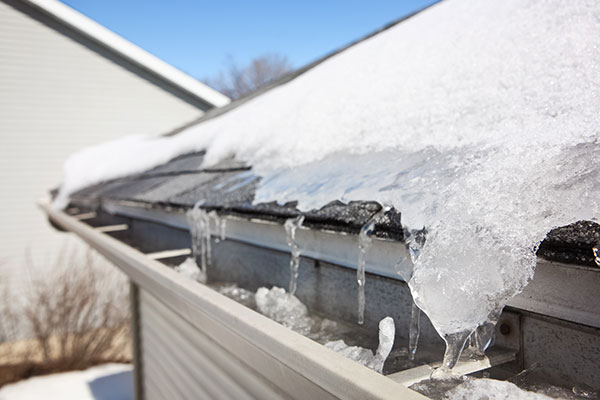
Each year, 1 in 50 insured homes will file a claim with their insurance company for water damage or a freezing-related issue. With ice dams being so common, there are ways to help prevent them or to reduce the damage caused by them. To start, temperature control is the best method of prevention.
Escaping heat is usually the root cause of ice dams. During the winter, it is a good idea to check for moisture and water stains on ceilings and walls where the ice build-up may be.
If you have found an issue with water getting into the home, or possible excess moisture, you can cool down the roof or attic space to help re-freeze the water (if it’s cold enough outside to freeze).
High-powered fans pointed in the area can help to cool it down. Having the water freeze again will ultimately stop the water from leaking into your home causing more water damage. In addition to the water damage, there is also a high risk of mold and mildew damage.
It is also recommended that any more than 1 foot of heavy, wet snow & ice build-up should be removed from the roof. This can prevent not only ice dams but also a weakening of the roof and overall structure.
It is like brushing off a foot of snow from your car, it is usually mixed with ice and can be very heavy. Those who have had to shovel their car out know what that’s like. Having that covering an entire roof could be very dangerous.
Lastly, keep all downspouts clean and clear of snow and ice. Some people have gutter guards that help to prevent leaves and other debris from clogging up the gutters. These are great but can cause snow to pile up on the surface.
There is also another way to prevent ice dams from forming, and that is by having heat cables (aka heat tape, heat wire) installed on the roof.
These heat cables heat up the space on your roof to prevent ice dams from forming. They create a path for water to flow in the snow so that ice dams can't form or in the event that they are formed already, will hollow out space for the water to drain.
Ice Dam Removal
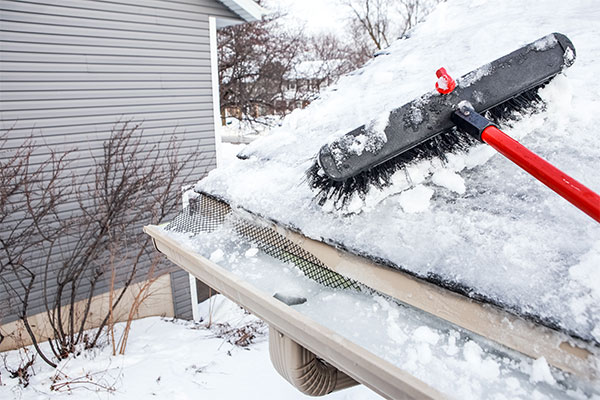
Ice dam removal can be quite dangerous and is recommended to leave it to a professional to remove. Climbing up a ladder to get to a snowy, icy roof is never a good idea (unless you are experienced in doing so).
There are other methods to remove the ice dam safely. For example, you can use a roof rake to remove the snow. Some have wheels on them to make it easier, and they are meant to be used from the ground.
You should NEVER attempt to chip away the ice with a shovel or chisel. Not only is it very dangerous to be on the roof, but there is also the risk of damaging the roof itself.
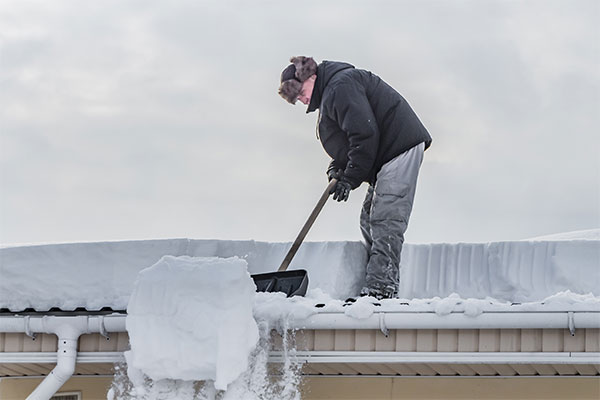
Some people may think that using rock salt can help melt the ice and snow on their roofs. While it will do the job, DO NOT use rock salt/calcium chloride. It can cause damage to the roof, and the melted, now salty, water can cause damage to paint and any plants on the ground.
Any commercial or residential building is at risk for ice dams. Waiting too long to take care of it can cause even more damage. Long, large icicles can be a sure sign of ice dams.
If you see these, it is highly recommended to have a professional come out to not only take down the icicles but also check for possible ice dams on your roof.
Ice Dam Damage
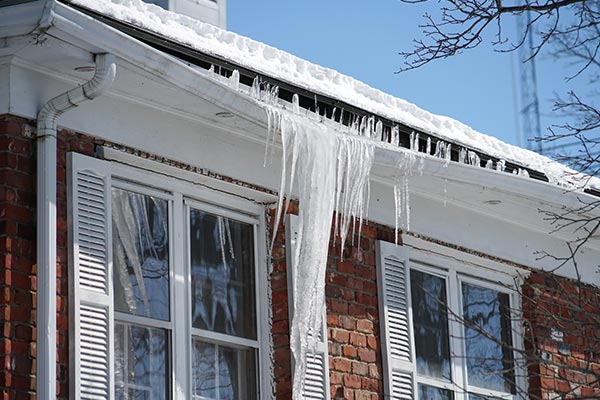
Damage from an ice dam can be extensive. Various kinds of damage can occur including water damage inside the home, mold, mildew, damage to the roof itself, and/or broken gutters and windows.
Icicles can be beautiful to look at. The sun shining on them can make them sparkle. You wonder how they can get so big and not break at all.
Icicles form when snow or ice begins to melt and drip. If the air is cold enough, those water drips begin to freeze. It is a constant process of melting and freezing which will make them longer and bigger.
Although pretty, they can be very scary and damaging. As ice accumulates, they get longer and larger. The weight of them on gutters can bring the gutter right down.
Gutters being ripped down can expose the fascia board and other parts of the roof like the roof sheathing (the plywood under the shingles). Moisture in these areas can be especially damaging due to wood rot, mildew, and mold growth.
Leaking ice dams can also cause a significant amount of water damage. With the snow melting, water can drip down into insulation, down through ceilings and exterior walls under eaves.
The longer it takes to resolve the issue, the more likely it is that structural damage would occur as well. Extensive water damage can also ruin sheetrock and paint. If an ice dam breaks free, even more damage can occur.
A large sheet of ice being released off a pitched roof surface can bring shingles and gutters down with it. Not only that, but the ice can break through windows, damaged vehicles, and possibly harm people and pets. Anything it lands on is likely to be crushed like bushes and landscaping.
If you have experienced any damage related to an ice dam, excess snow, or ice melt, Rock Emergency professionals are the ones to call. 24/7 emergency services are available in and around the Rochester, NY area.
All of our professionals are trained to handle a variety of situations and will be prepared to effectively resolve any issues you may be having related to water damage. Remember, We’re In This Together!
Share this Post
